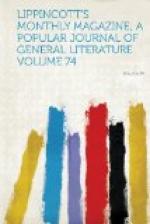completely out of the modern world, and nobody knows
anything about it save a few lovers of ancient art,
who will not be beat in their explorations by want
of communications and bad hostelries. But the
little hill-city possesses two churches, whose choirs
well deserve a visit by the admirers of cinque-cento
wood-work, I have mentioned it here, however, mainly
because one of these, the choir of the cathedral,
offers not so much in what may still be seen there,
as in its records, a very curious example of the spirit
of anti-ecclesiastical freethinking which was widely
spread at that time through the artist-world, whose
best patron was the Church. I mentioned some months
ago, in the pages of this Magazine, some curious facts
showing the real sentiments of the great Perugino
on this subject while he was painting Madonnas and
miracles for his ecclesiastical patrons. And the
following singular extract from the archives of the
cathedral church of Todi may be added to what was
there written as a proof of the somewhat unexpected
fact. The wood-work of the choir was begun by
Maestro Antonio Bencivieni of Mercatello, in the duchy
of Urbino, and was completed in 1530 by his son Sebastian,
who finished his work by inserting in it a singularly
haughty inscription in intarsia. The Latin of
the original may be Englished thus: “Begun
by the art and genius of Ant^{o} Bencivieni of Mercatello.
This work was finished by his son Sebastian. Having
kept faith and maintained his honor, he did enough.”
The worthy canons, however, discovered just one and
forty years afterward that Maestro Sebastiano had
done somewhat too much. For he had on the fourth
stall, counting from the bishop’s seat, on the
right-hand side of the choir, inserted amid the ornamentation
certain Latin words, inscribed over a carving of three
vases intended to represent reliquaries, which may
be translated thus: Over the first vase, “The
shadow of the ass ridden by our Lord;” over
the second, “The feet of the Blessed Virgin as
she ascended into heaven;” over the third, “Relics
of the Holy Trinity.” These strange inscriptions
remained where Maestro Sebastiano had so audaciously
placed them till the May of 1571. At that date
we find a record in the cathedral archives which,
after rehearsing the words in question, and describing
the position of them, proceeds: “Which words,
placed there and written scandalously, and in a certain
sort derisive of the veneration for holy relics, and
in contempt of the Christian religion, the very reverend
canons” (So-and-So—names rehearsed)
“ordered to be removed and entirely canceled,
so that they should no longer be seen or read.”
Can it be supposed that this very extraordinary inscription
in a choir frequented daily by the canons of the church
had entirely escaped notice for more than forty years?
Surely this is impossible. Should we not rather
see in the fact that the chapter of 1530 noticed the
mocking words with probably a shrug and a smile, whereas
the chapter of 1571 took care that they were removed,
an interesting and curious commentary on the change
which the intervening years had brought about in the
spirit of the Church, and another unexpected indication
of the difference between the Church of the worldly,
pagan-minded Clement VII. and that of the energetic,
earnest bigot Pius IV. That such a difference
existed we know full well, but this passage of the
Todi archives is a very curious proof of it.




